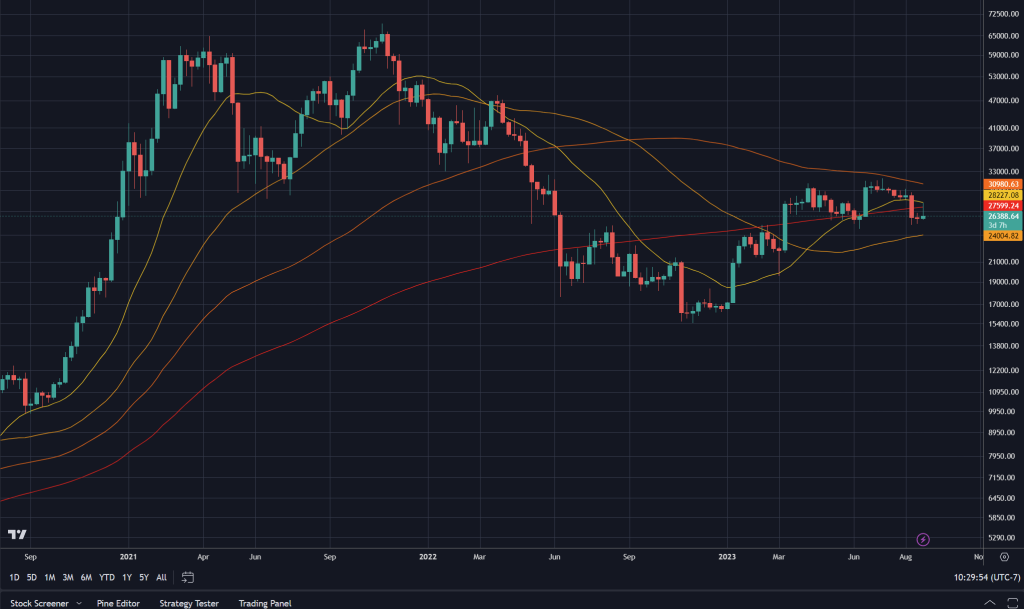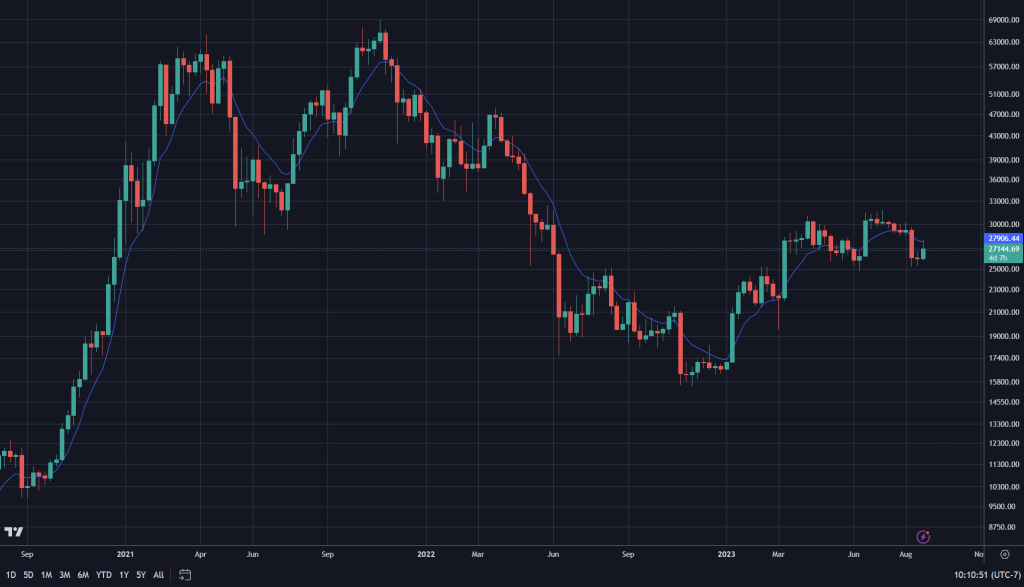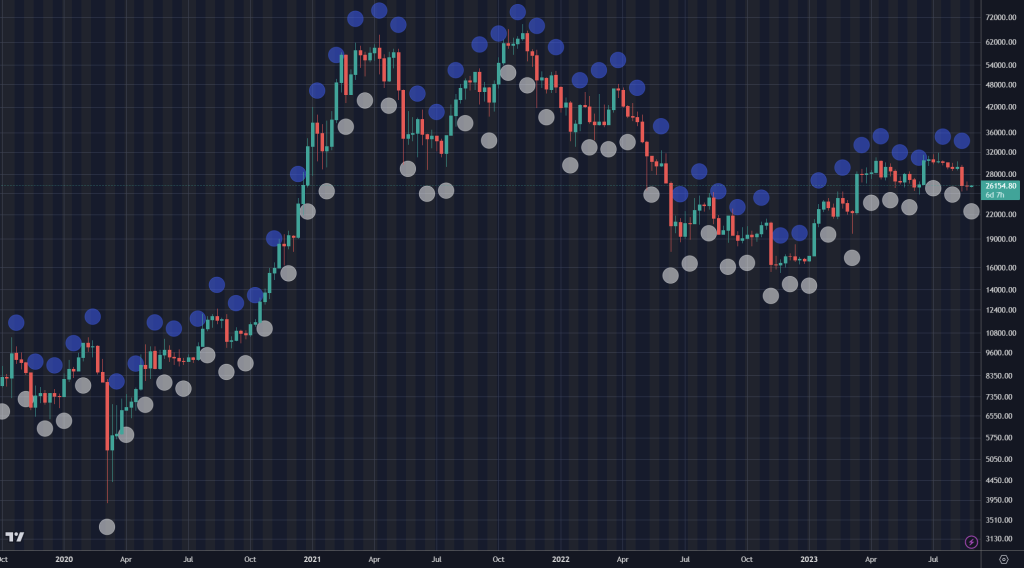
The Moving Average Ribbon Indicator is a powerful tool. It helps traders make informed decisions. It shows different moving averages on one chart. This helps traders identify entry and exit points.
This indicator gives a comprehensive view of price action. Traders can observe how the moving averages interact with each other. This helps them identify trends and reversals.
The ribbon format shows multiple moving averages. This is better than looking at individual averages. It gives a visual representation of market sentiment.
If the ribbon shows shorter-term averages above longer-term ones, it suggests a bullish trend. If the ribbon crosses over or compresses, it may indicate a reversal.
Investopedia.com says this indicator is good for trending markets. It helps traders capture profits and avoid false signals. This indicator gives traders crucial insights. This helps them have more successful outcomes in financial markets.
What is the Moving Average Ribbon Indicator?
The Moving Average Ribbon Indicator is an awesome tool for technical analysis. It shows trends and support/resistance levels on a chart with multiple moving averages. Each average is the price over a given period, like 10 or 50 days.
Using it helps traders get an idea of the market’s movements and make better decisions. Plus, the ribbon’s display lets traders see how strong the trend is and where it might reverse. When tightly packed, the market is probably range-bound. When spread out, it suggests a strong trend.
This indicator stands out because it looks at multiple timeframes. This makes it more accurate and reliable than other indicators. Also, traders can customize it with their own values and colors. Short periods (10 or 20 days) give quicker signals for short-term trades. Longer periods (50 or 200 days) are better for long-term trades.
To get the most out of it, combine it with other tools, such as volume indicators or oscillators. That way, you get a deeper understanding of the market and trade more accurately.
Don’t forget to use the Moving Average Ribbon as part of a whole trading strategy. Combine its signals with fundamental analysis and risk management techniques for the best outcome. Mastering this tool and integrating it into your trading can help you succeed in the financial markets.
Benefits of Using the Moving Average Ribbon Indicator
The Moving Average Ribbon Indicator has many advantages that can improve your trading strategy. Here are five main advantages:
- Adaptability: It is easily adjusted to different market conditions. By using multiple moving averages, it gives an overall view of price trends, showing both short and long-term trends.
- Trend Confirmation: An important benefit of this indicator is its ability to confirm trends. The ribbon lines provide clear visual cues when markets change, helping you make smarter decisions.
- Support/Resistance: Not just identifying trends, the indicator is useful for pinpointing support and resistance levels. The ribbon lines act as shifting zones for entering/exiting trades.
- Volatility Assessment: You can gauge market volatility better with this indicator. Its widening or narrowing shows changes in volatility, so you can adjust strategies.
- Filter for Signal Accuracy: With multiple moving averages, the ribbon filters out false signals and noise. It gives a smoother representation of price action and helps you focus on high-probability setups.
The Moving Average Ribbon Indicator also has customizable settings, letting traders adjust parameters based on their preferences and style. To get the most out of these benefits, consider adding the indicator to your technical analysis toolkit. Enhance your decision-making process and stay ahead in the markets!
Understanding the Components of the Indicator
To understand the components of the moving average ribbon indicator, delve into the world of exponential moving averages (EMA) and setting up multiple EMAs for the ribbon. Each sub-section offers its own unique solution to enhance your understanding and utilization of this powerful indicator.
Exponential Moving Averages (EMA)
Exponential Moving Averages (EMA) are an essential tool used by traders and analysts to interpret and predict price trends in finance. They work by taking the sum of closing prices over a certain period and dividing it by that same number. The formula gives more weight to recent prices, meaning it’s faster to react to shifts in market sentiment. This makes it great for generating buy or sell signals with better accuracy.
Gerald Appel first developed EMAs in the late 1960s for analyzing stock market data. His groundbreaking work set the stage for technical analysis methods still used today. Since then, many traders have seen the value of EMAs and incorporate them into their plans. It’s clear that EMAs are a timeless and invaluable asset for financial decision-making.
Setting Up Multiple EMAs for the Ribbon
Let’s set up multiple EMAs with different periods on the chart. This way, we can get a better view of the market trend while filtering out short-term fluctuations. We can create a ribbon pattern with these EMAs for better visibility.
We have an example here:
- Period: 10, EMA: Blue, Color: #0072ce
- Period: 20, EMA: Red, Color: #ff0000
- Period: 50, EMA: Green, Color: #00cc46
- Period: 100, EMA: Cyan, Color: #00ffff
Shorter period EMAs (e.g. 10 and 20) respond to price changes faster. Longer period EMAs (e.g. 50 and 100) capture bigger trends. By looking at the EMAs, traders can find out the market behavior. If the shorter EMAs are above the longer ones, it indicates bullish. If the shorter EMAs go below the longer ones, it suggests bearish.
Using this ribbon technique can be beneficial for technical analysis. It can give clarity and help identify trends more accurately.
John Murphy is the one who first introduced this indicator. He is a renowned technical analyst and author of “Technical Analysis of the Financial Markets”. His method changed the use of moving averages in trading strategies and helped traders make better decisions.
Interpreting the Moving Average Ribbon Indicator
To interpret the Moving Average Ribbon Indicator in order to make informed trading decisions, you need to understand how it works. This section explores the different aspects of the indicator, including identifying trends and signal generation. By delving into these sub-sections, you will gain a comprehensive understanding of how to effectively utilize the Moving Average Ribbon Indicator.
Identifying Trends
The Moving Average Ribbon Indicator assists with detecting trends. It does this by studying price changes over a given period. It plots several moving averages on the chart, showing the overall trend’s direction.
To make trend identification more precise, various combinations of moving averages can be used. For instance, the ribbon pattern formed by closely spaced moving averages could indicate a stronger trend and more momentum.
Linda Raschke was the first to introduce this indicator. Her creative approach changed trend detection approaches and helped traders make informed market decisions. The indicator stands out for its ability to fit different timeframes and detect both short-term and long-term trends.
Signal Generation
Generating signals with the moving average ribbon indicator? For traders, certain conditions and patterns are key. By analyzing the interaction of many moving averages, buy or sell signals can be detected. See the table below for specifics.
It’s important to track price movements in relationship to the ribbon and take appropriate action. To increase accuracy, traders should also consider other technical analysis tools and indicators to confirm signals.
Fun fact: The moving average ribbon indicator was made popular by technical analyst Linda Bradford Raschke.
Strategies for Using the Moving Average Ribbon Indicator
To maximize your success in using the Moving Average Ribbon Indicator, employ effective strategies. Harness the power of this tool with the Trend Following Strategy and the Reversal Strategy. Each approach offers distinct advantages that can enhance your trading decisions.
Trend Following Strategy
Trend following is an approach used by traders to spot and benefit from sustained market trends. By studying price changes over a period, traders can find the trend direction and make informed decisions. To apply this strategy, traders need various tools and indicators that give accurate trend signals. An example is the Moving Average Ribbon Indicator.
This Indicator is handy for detecting trends and potential entry or exit points. It contains several moving averages of different time periods plotted on the chart. See the table below as an example:
| Moving Averages | Time Period |
|---|---|
| 10-day MA | Short-term |
| 50-day MA | Intermediate |
| 200-day MA | Long-term |
By studying the positioning of these moving averages in relation to each other and the current price, traders can see if the market is going up or down. When the shorter-term moving average crosses above or below the longer-term moving averages, it suggests a reversal or continuation.
Apart from identifying trends, this Indicator also helps traders identify support and resistance levels. If prices are staying above moving averages, it shows an uptrend with strong support. On the other hand, if prices remain below moving averages, it suggests a downtrend with strong resistance.
To benefit from this strategy, traders should use it with other technical analysis tools to get confirmation and use proper risk management techniques. By following this trend following strategy, traders can stay ahead and potentially benefit from profitable trading opportunities.
Maximize your trading potential today! Incorporate the Moving Average Ribbon Indicator into your strategy and increase your chances of success in capturing profitable trends. Stay informed, adjust to changing market conditions, and make timely trading decisions to stay ahead of the competition. Take action now and unlock your trading potential!
Reversal Strategy
A reversal strategy is a strong tool traders use to recognize potential market trend shifts. Analyzing different indicators assists traders to know when to enter or exit trades. Here we look at the essential components and techniques of a reversal strategy.
For successful reversal strategy implementation, traders have to consider multiple factors and indicators. Check out the table below for key elements:
| Indicator | Description |
|---|---|
| Moving Average | Calculates average price over a period. Helps figure out trend directions. |
| Candlestick Patterns | Analyzes shape and structure of price movements to forecast trend reversals. |
| Support and Resistance Levels | Identifies areas where buying or selling pressure disrupts trend movements. |
| Volume Analysis | Examines trading volume to predict potential trend reversals. |
These indicators work together to provide multiple outlooks on reversals. By studying moving averages, candlestick patterns, support and resistance levels, and volume analysis, traders can make informed decisions about entering or quitting trades.
Here are some tips for optimizing your reversal strategy:
- Merge multiple indicators: Using several indicators together gives more complete confirmation signals when spotting potential reversals.
- Change indicator settings: Try different periods or parameters for your selected indicators to find the ideal settings for your trading style.
- Follow price action: Keep an eye on price behavior around significant support and resistance levels. Breakouts or rejections at these levels can be strong signs of upcoming reversals.
- Use stop-loss orders: Set stop-loss orders to limit potential losses if a reversal doesn’t occur as predicted. This risk management approach guarantees you exit trades quickly if market conditions differ from your predictions.
By using these ideas in your reversal strategy, you can improve the accuracy and effectiveness of your trades. Always pay attention to market conditions and modify your plan as needed to fit changing trends and trading environments.
Tips and Best Practices
It’s essential to know the best practices for using the Moving Average Ribbon Indicator. Here are 3 points to keep in mind:
- Pick the right time frame. Shorter frames like 5/15 minutes are great for day traders, while longer frames like daily/weekly are better for swing traders or long-term investors.
- Confirm trend direction. Observe the slope & position of multiple moving averages to see if the market is going up or down. This helps make trading decisions.
- Combine with other indicators. The Moving Average Ribbon Indicator can be even more effective when used with other tools like oscillators, volume indicators, & support/resistance levels.
To maximize potential, stay educated on market news & events. Adapt your strategy & you’ll enhance trading performance with the Moving Average Ribbon Indicator. FYI, traders have been using moving averages since the start of technical analysis! This indicator has been a go-to for many markets.
To Sum up
The Moving Average Ribbon Indicator is a powerful tool for traders. It visually presents multiple moving averages, aiding in the identification of trends and potential reversals. Making informed decisions about when to trade is easier with this indicator.
Plus, it can display different timeframes simultaneously, giving a comprehensive view of the market.
Customize the indicator to fit your trading style. Change the number of moving averages displayed and their periods. This makes it suitable for short-term and long-term traders alike.
Combine this indicator with other technical analysis tools to refine your strategy. Incorporating MACD or RSI will confirm signals generated by the ribbon indicator, making trades more reliable.
This real-time insights provider is a valuable asset for traders. It eliminates guesswork and emotions from trading decisions.
Pro Tip: Use risk management techniques like setting stop-loss levels or trailing stops. This will protect your capital and minimize losses if the market turns unfavorable.
Frequently Asked Questions
FAQs for How to Use the Moving Average Ribbon Indicator:
1. What is the Moving Average Ribbon indicator?
The Moving Average Ribbon indicator is a technical analysis tool that consists of multiple moving averages plotted on a chart to identify trends and generate trading signals. It helps smooth out price fluctuations and provides a visual representation of the overall direction of an asset’s price movement.
2. How many moving averages are typically used in the ribbon?
The number of moving averages used in the ribbon indicator can vary based on individual preferences or the trading strategy employed. However, it usually consists of 3 to 10 moving averages, which are spaced out at specific intervals. The more moving averages in the ribbon, the smoother the trend representation.
3. How do I interpret the Moving Average Ribbon indicator?
When the moving averages in the ribbon are stacked in a particular order, it indicates the dominant direction of the trend. If the moving averages are lined up from smallest to largest, it suggests an uptrend, while the opposite order signifies a downtrend. Traders look for crossovers and divergences between the moving averages to identify potential entry and exit points.
4. Can I customize the Moving Average Ribbon indicator?
Yes, the Moving Average Ribbon indicator can be customized according to individual preferences. Traders can select the number of moving averages, their types (simple, exponential, weighted, etc.), and the intervals between them. These settings can be adjusted based on the time frame and volatility of the asset being analyzed.
5. How can I use the Moving Average Ribbon indicator in my trading strategy?
The Moving Average Ribbon indicator can be used in various ways to support trading decisions. Some common strategies include using crossovers of the moving averages as signal triggers, watching for divergences between price and the ribbon, and using the ribbon as a dynamic support/resistance level. It is advisable to combine the indicator with other technical tools and analysis techniques for better accuracy.
6. Which trading platforms offer the Moving Average Ribbon indicator?
The Moving Average Ribbon indicator is available on most popular trading platforms, including MetaTrader, TradingView, and Thinkorswim. Traders can access the indicator through the platform’s built-in selection of tools or by importing custom indicators created by other users.

